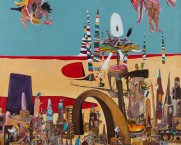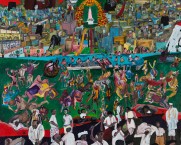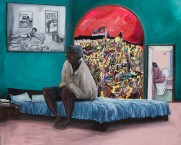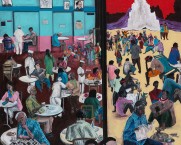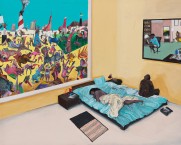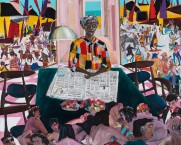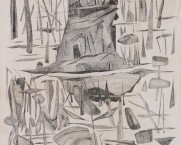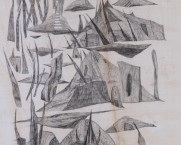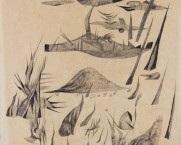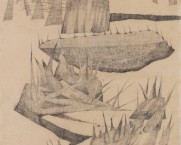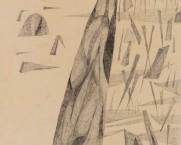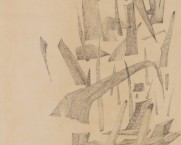C&L Shows
It Is Getting Louder
Nityan Unnikrishnan
2020
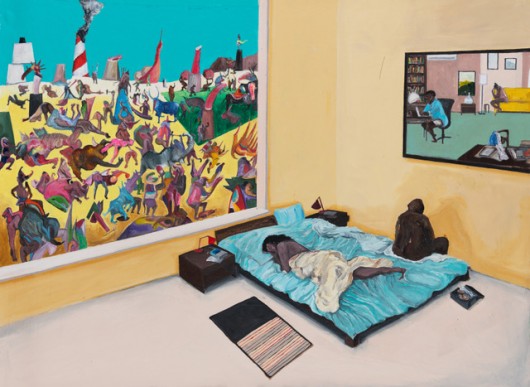
Overview
A murmur, seizing me, I can’t master its source, its increase is out of my control. The noise, the background noise, that incessant hubbub, our signals, our messages, our speech and our words are but a fleeting high surf, over its perpetual swell.
Michel Serres
In Nityan Unnikrishnan’s paintings, we find fleeting moments of silence: time to breathe in the stillness of a room, to sit with a newspaper, to rest one’s gaze on the opaque plane of sky between structures and figures. The quiet is never allowed to lengthen; it registers, inevitably, the tremor of a surrounding cacophony. The dissonance and the clutter refuse to be blocked out, even in the enclosed hush of a bedroom. The noise will not be cancelled, though it falls away for a brief interlude.
Like junk, people fill the land. They make up no community and no aggregate, but are strewn and seated randomly, arrhythmically. The ground beneath them seems to have materialised for no reason other than to hold them: it is not simply unmapped but unmappable, a span of space that could be the beach at the end of the world, a fairground in a different galaxy. The sky is flatly aqua or scarlet, either chilled into alien blankness or on fire.
There’s no mistaking where we are, though. In The Last Clearance Sale on Earth, the signs of New India crown and supersede a familiar chaos. A vast cityscape of apartment buildings and tenements—higgledy-piggledy, labyrinthine—blurs into an infinite lateral spread, but we do not see the lives within. Instead, the eye is drawn to well-fed bodies gambolling in a water park, the remade Central Vista stretching out beyond a phallic new India Gate, the massive compound of a detention centre dwarfing the scene. We see white-clad figures in the foreground, ordinary people performing the postures of their existence, but they seem almost bleached of life, like mourning statuary or ghosts. The painting’s vitality is claimed instead by the shape-shifting, flame-fed creatures in the middle, capering in a carnival of the grotesque.
Unnikrishnan’s gaze is panoramic and unsparing. In his play with colour, line, and form, we find painterly pleasure, of course. There is quietness in his absorption. But a ferocious will to record also drives the intensity of his engagement: the meditative working of acrylic onto khadi to form each telling detail of injustice and ugliness (the Dalal Street bull rearing in monumental triumphalism; a tuxedoed impresario overseeing the burning of books). There is madness in the detailing, at times. In The Crying Wolves, one of Unnikrishnan’s aged men, a grave presence who seems to have floated in from his earlier work, presides over the scene, his newspaper spread open to unleash its quotidian horrors. Bedlam breaks out all around—fleshly sybarites heaving and piling before the table, their skin the colour of boiled ham; preternatural chimerical beings posing along the sides of the corridor, framed in what could be windows or paintings. Are these visions emerging from out of the newspaper, one wonders—the libidinal excess and anarchy implied, unstated, in its black-and-white? It takes a fierce and compulsive concentration to render each minuscule line of newsprint. But it must be done; accounts must be kept. We know what happens otherwise: in The Half of It, a similar elderly gentleman pores over a similar broadsheet, but this one is riddled with black squares, the news redacted and censored.
That painting offers implicit testimony to the pandemic and lockdown in which the artist made most of these works. At home in Goa, as fruits and vegetables ran scarce, so did art supplies. Unnikrishnan divided the last piece of fabric he had with him into three, and painted The Half of It on one portion of the rationed cloth. It is not the only act of partition here. Within the painting, too, a boundary runs down the middle, separating the homely disorder of a Kerala coffee house from the migrant labourers and office workers scattered outside on an unreal stretch of land, blank beneath the blood-red sky. For the artist, the boundary seemingly places the remembered world on one side, the imagined world on the other. But both worlds attest to time out of joint; the new Indian landscape has room for neither.
Unnikrishnan parses the crowd as assembled characters, their bodies angling away from one another, their gazes never quite meeting. It is a congeries of individuals and experiences, not a coherent entity. Something else transpires when we move to the personal, interior paintings, so clearly touched by the influence of Sudhir Patwardhan—in the way social spaces are framed, separate but adjacent; in the faces and forms of people inhabiting their spots of time. We feel it most acutely in The House Tilts and Late Fragment, two works that offer space as plenum, brimful of the presence of people dwelling together in a particular moment. In each, a couple lives in the clean space of a quiet room. Their bodies seem moulded out of dark clay; the bed is turning to water. The furniture is spare and familiar. A painting on the wall doubles and redoubles their story, offering us further bodies in a further shared solitude. These frames draw us into a depth of space, make the entire work a play of interiority.
But in both works, we find also a view of the disordered reality outside, gatecrashing the silence. These views frame a profuse, even delirious metamorphosis reminiscent of Hieronymus Bosch, a parade of hybrids and mutants doing and undoing each other. There is no essence or fixity here, only a torrential becoming. The lockdown roots us in our cool and peaceful interiors, but the artist will not allow us to forget the chaos beyond them. In painting after painting, these cavorting apparitions loose a wild energy upon the scene, a noise that can be neither explained nor contained.
The landscape Unnikrishnan makes for us in these works is festooned with monstrous erections, priapic assertions of power. But where the phallus (that ultimate statue of unity) insists on singularity, Unnikrishnan’s multiple replication of its form ridicules that claim, reduces it to a joke. This is not the supreme sceptre: these are just penises.
In the lockdown, the khadi ran out. Maybe the artist moved beyond narrative, to a more sublime understanding of multiplicity and mutability. In his pencil drawings, on malmal and on bamboo fibre paper, we find again the time of becoming, the space of in-betweenness. Shapes seem to carry life within them, but it is a life outside of classification, a vegetation that is both unknowable and familiar. In these works, finally, we inhabit uncanny dreamscapes without human form. Their quietness imagines another world altogether—past, future, or perhaps just elsewhere.
~ Mandakini Dubey

